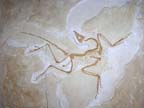 |
 |
 |
 |
 |
Produced
by the Population Genetics and Evolution class, Furman University |
||||
 |
 |
 |
 |
 |
Produced
by the Population Genetics and Evolution class, Furman University |
||||
 |
The
Paleogene: Phorusrhacids |
 |
||
| Phorusrhacids
(Terror Birds) were a group of large, flightless, carnivorous birds that
dominated South America (Wikipedia 2010). The average height of the predators
varied from 1-3 meters (Wikipedia 2010; National Geographic 2005). The
smallest terror bird was Psilopterus lemoinei, that was approximately
the size of a harpy eagle (1 m tall). The largest (Brontornis burmeisteri)
stood approximately 10 ft and weighed over a half ton (NationalGeographic
2005). Because their beaks resemble those of modern predatory eagles and
scavenging vultures, phorusrhacids are believed to have been carnivorous
birds (NationalGeographic 2005). Larger species could easily crush the
skulls and break bones of its prey using its powerful beak and legs (Wikipedia
2010; NationalGeographic 2005). These birds evolved in isolation until
South and North America collided (NationalGeographic 2005). As a result
of the central american land bridge and faunal exchange between the contintents,
some recent species like Titanis walleri has been found in areas
as far north as Texas and Florida (Wikipedia 2010; ScienceBlog 2010).
However, this collision is also considered to be the cause of the extinction
of the Phorusrhacids. The collision allowed North American predators (Jaguars
and Saber-toothed cats) may have out-competed the remaining terror birds
to extinction (NationalGerographic 2005). Two species of extant South
American birds, Seriemas, are 80 cm-tall and are considered to be their
closest modern relatives. Page by Matt Medlin |
 |
| Phorusrhacid. Photo from: photobucket.com | |
|
Wikipedia. 2010. Phorusrhacidae. Wikipedia. Accessed April 18, 2010. Naish D. 2008. Raven, the claw-handed bird, last of the phosusrhacid. ScienceBlogs.com. Accessed April 18, 2010. Pickrell J. 2005. Terror Birds: Predators with a Kung Fu Kick?. NationalGeographic.com. Accessed April 18, 2010. |